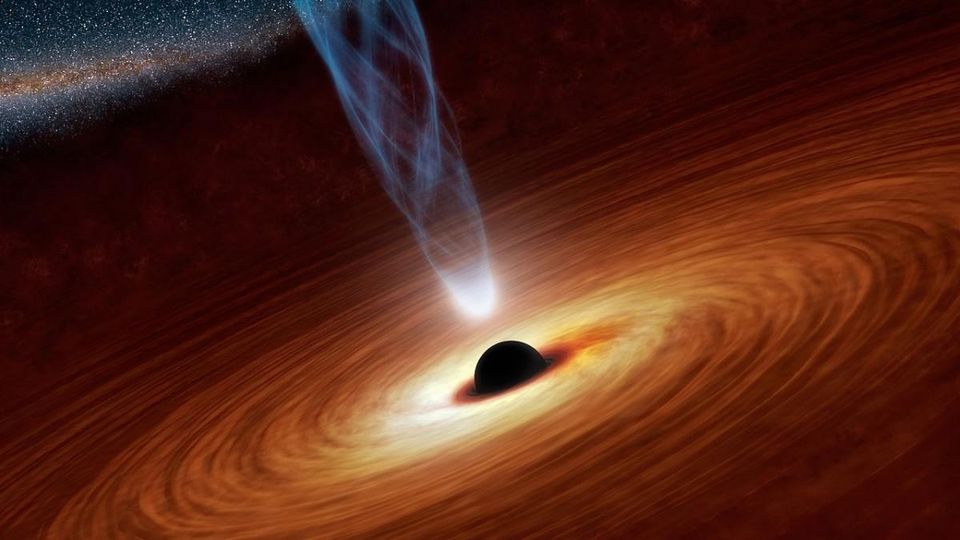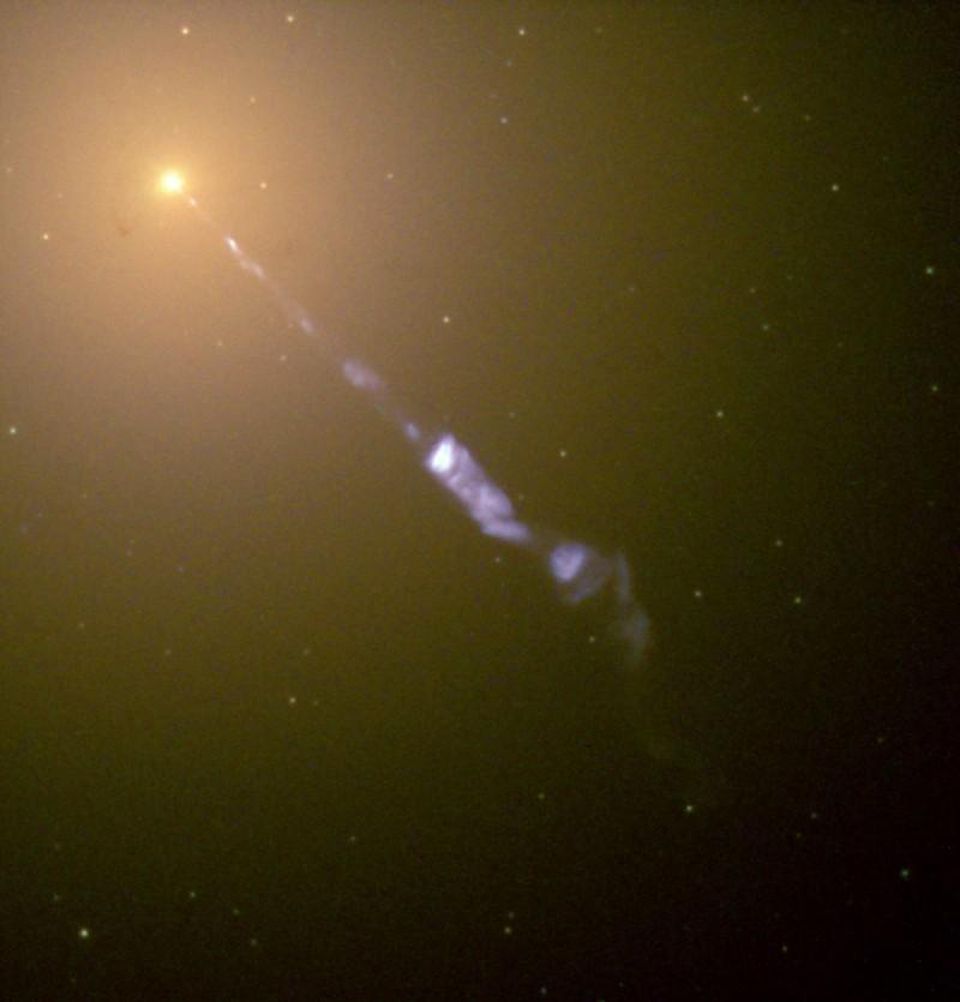Ask Ethan: How does Hawking radiation and relativistic jets escape from the attraction of a black hole?

Conceptual image of an accretion disk and jets of a supermassive black hole
The most important feature of the black hole is the event horizon. This is a region of space within which the gravitational field is so strong that nothing, not even light, can escape from there. How can we explain the predicted escape of matter and radiation from black holes? Our reader wants to find out:
Everywhere, where you read information about black holes, it is written that "nothing, not even light, can escape from there." And then you meet information about Hawking radiation, "black body radiation, which, as predicted by scientists, emit black holes." And then there are relativistic jets that “black holes shoot at speeds close to light”. Obviously, something still escapes from black holes, right?
Matter and radiation, located near black holes, can really come to us. But does this mean that something is escaping from the black hole? Let's figure it out.

Remote galaxies, in which quasars and active nuclei are located, are often better observed in visible or infrared light, but the jets themselves and the accompanying emissions are best seen in the X-ray and radio frequency range - as shown in the photo of the Hercules A. galaxy, but this does not mean that all observable matter and radiation come to us from within the event horizon.
Speaking about BH, it is important to understand what we mean. If a sufficient amount of mass is gathered in a sufficiently small region of space, the curvature of space-time will increase so much that the light beam appearing there, regardless of the direction of propagation, will still come back to the central singularity. The speed of runaway - the speed with which it is necessary to move in order to overcome the gravitational attraction of the BH - exceeds the speed of light. The consequence of this is the horizon of events - a critical region, crossing the boundary of which is no longer possible to get out. And everything within the horizon of events is always in a singularity; all that is outside can either avoid it or fall inward, depending on the available properties.
')

Breakthroughs in the manufacturing technology of optical devices and imaging allow us to better and better probe and understand the physics and properties of remote quasars - including the properties of central BHs
However, there are real particles and radiation, both theoretical and observable, the source of which are BH. A brilliant example is the accretion disk. Imagine that you are a particle that is outside the horizon of BH events, but is gravitationally associated with it. A strong gravitational attraction will lead to the fact that you will move in an elliptical orbit, and the highest speed when moving along it will correspond to the strongest approximation to BH. And as long as you do not cross the horizon, you should not fall inward. If there are enough particles in orbit, you can interact with others, experiencing inelastic collisions and friction. You will warm up, move in an increasingly circular orbit, and eventually begin to radiate.
This radiation does not come from inside the BH, but from matter moving in an orbit around it, outside the event horizon.

An illustration of an active black hole that accrets matter and the accelerating part of it, firing two jets perpendicular to the disk. It is possible to correspond to the BH located in the center of our Galaxy, and in general all the most active BH
Of course, part of the matter will eventually lose enough energy to cross the event horizon and get into the singularity, increasing the BH mass. But near the BH a lot of things happen. There are charged particles with opposite signs and the amount of charge moving rather quickly in space: at a speed close to the light one. Charged objects in motion create magnetic fields, which causes many ionized particles to spiral in a spiral, away from the plane of the accretion disk. These accelerating particles and generate relativistic jets, throwing in an excess of particles and radiation during collisions with matter located further from the BH.

Galaxy Centaurus A , shown in a composite image based on visible light, infrared light and X-rays
Relativistic jets are a remarkable sight, and, in some cases, so bright that they can even be seen in visible light. The galaxy Centaurus A has two jets directed in different directions, which turn into a large scattered spot; Messier 87 has one collimated jet, extending for more than 5,000 light years. All these jets are generated by active supermassive BHs, many times larger than even the monster of four million solar masses lurking in the center of the Milky Way.

The second in the list of the largest BHs observed from Earth, located in the center of the galaxy M87, is about 1000 times the mass of the BH in the center of the Milky Way, but it is located 2000 times farther from us. Relativistic jets emanating from the center are among the largest and collimated jets ever observed by man.
In the case of accretion disks and relativistic jets, all observed phenomena occur near the BH, but at the same time nothing escapes from the inside of the BH to the outside. In the case of Hawking radiation, everything becomes more confusing. In theory, one can imagine a BH located in a vacuum, having no matter or radiation in the vicinity. And if this BH were not there, you would observe only a vacuum of flat, non-curved space, governed by the fundamental laws of the Universe. But if you place the BH there, you will get a curved space, an event horizon and the laws of physics. As a result, radiation directed in all directions with a black body spectrum will appear: Hawking radiation.

BH event horizon is a spherical or spheroid region from which nothing, not even light, can escape. But outside the event horizon, the presence of BH radiation is predicted.
The problem with understanding Hawking radiation is as follows: all radiation occurs from outside the event horizon, but it receives energy only from the BH mass. For each quantum of energy (E) emitted in the form of Hawking radiation, the BH mass (m) should be reduced by an equivalent value. And how much? Exactly as much as dictated by the most famous Einstein equation, E = mc 2 . But how can the radiation outside the BH be caused by the mass of the BH inside it, especially if nothing can escape from the event horizon?

Visualization of how a BH would look on the background of the Milky Way
The most common explanation given by Hawking himself is at the same time the most incorrect. One of the ways to imagine the vacuum energy inherent in the space itself is a particle-antiparticle pair. Empty space with positive zero energy cannot be thought of as completely empty; something must occupy him. By combining this fact with the Heisenberg uncertainty principle, you come to an idea in which particle-antiparticle pairs arise for a short time and then annihilate back into the void of space. When one member of a pair is out of the event horizon, and the other gets inside, the outer one can run away, carrying energy away, and the inner one, carrying negative energy, reduces the black hole mass.

Particle-antiparticle pairs constantly appear and disappear, both inside and outside the BH event horizon.
But, first, this representation does not work for real particles, but virtual ones. These are simply methods of conducting calculations, and not some physically observable entities. Secondly, Hawking radiation leaving the BH is mostly photons, not particles of matter or antimatter. Third, most of this radiation does not appear on the event horizon, but in a rather large region surrounding a black hole. If we use the explanation on the basis of particle-antiparticle, it is better to try to present them as a set of four types of pairs:
- Outside-outside
- Outside-inside
- Inside Outside,
- Inside-inside
Among them, the pairs outside-inside and inside-outside virtually interact, generate photons that carry energy, and the missing energy comes from the curvature of space, as a result of which the BH mass decreases.

Hawking radiation inevitably follows from the predictions of quantum physics in a curved space-time surrounding the BH event horizon. The radiation generates energy outside the event horizon, so the BH must lose mass to compensate
But the true explanation is not very easy to imagine, and that confuses many. In fact, it is necessary to calculate how the quantum theory of empty space behaves in a strongly curved region surrounding the BH. Not necessarily directly on the horizon of events, but in a large spherical region outside. If we carry out calculations of quantum field theory in a curved space, then there is an unexpected solution: the thermal radiation of a black body is emitted by the space surrounding the BH event horizon. And the smaller the event horizon, the greater the curvature of the space next to it, and the greater the Hawking radiation velocity.

With decreasing mass and radius of the BH, Hawking radiation becomes more and more temperature and power
But under no circumstances will it be possible to conclude that something crosses the event horizon, moving from the inside to the outside. Hawking radiation appears in the space surrounding the event horizon, and spreads away from BH. The loss of energy reduces the mass of BH, as a result of which it evaporates. Hawking radiation is an incredibly slow process, and the BH mass from the Sun to evaporation should take about 10 67 years. And at the BH in the center of the Milky Way it will take 10 87 years, and for the most massive BH in the Universe this may take even 10 100 years! And the last thing you see in the process of reducing BH is a bright, energetic flash of radiation and high-energy particles.

On a seemingly eternal background of continuous blackness, a single flash of light will appear: it will be the evaporation of the last BH in the Universe.
These last stages of decay, which will happen a long time after the last star burns, will be the last flashes of energy that the Universe will give out. This will be the last attempt of the Universe to create an imbalance of energy and the ability to create complex structures. The evaporation of the last BH will be the last attempt of the Universe to say the same thing that it said at the beginning of the hot Big Bang: “Let there be light!”
Source: https://habr.com/ru/post/374463/
All Articles